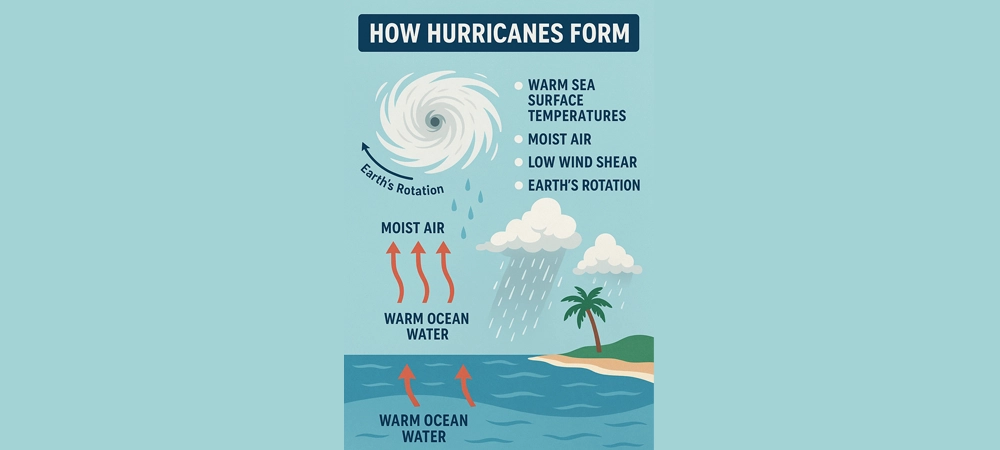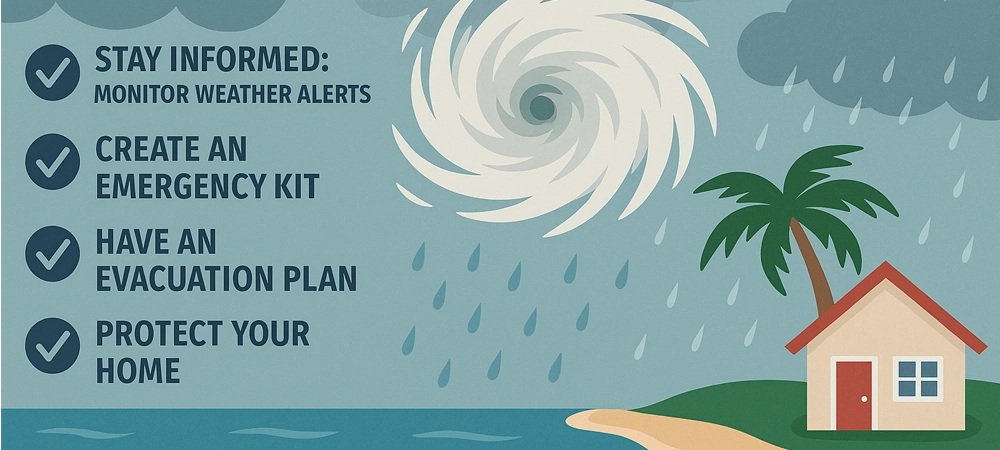Hurricanes are some of the most powerful and destructive weather events on Earth. These intense tropical storms bring fierce winds, heavy rainfall, and devastating storm surges. In this guide, we’ll break down what a hurricane is, how it forms, and why understanding these storms is essential—especially if you live in a coastal area.
A hurricane is a powerful, rotating storm system that forms over warm ocean waters in tropical regions. It is classified as a tropical cyclone with sustained wind speeds of at least 74 miles per hour (119 km/h). These storms are known for their massive size, intense rainfall, high winds, and potential to cause widespread destruction—especially when they make landfall.
Hurricanes develop in areas where the sea surface temperature is above 26.5°C (80°F), and they draw their energy from the warm, moist air over the ocean. As this air rises, it creates a low-pressure center, around which powerful winds begin to spiral due to the Coriolis effect (caused by Earth’s rotation). The result is a well-organized storm system with a characteristic eye—a calm, low-pressure center surrounded by towering thunderstorms known as the eyewall, where the most severe weather occurs.
In different parts of the world, hurricanes are known by other names:
- Typhoons in the Northwest Pacific Ocean
- Cyclones in the South Pacific and Indian Ocean
Despite the different names, these storms are the same meteorological phenomenon: tropical cyclones with sustained winds exceeding the 74 mph threshold.
Hurricanes are categorized based on their wind speed using the Saffir–Simpson Hurricane Wind Scale, ranging from Category 1 (least severe) to Category 5 (catastrophic). Understanding what a hurricane is—and how it behaves—is crucial for communities in coastal regions, where preparedness can save lives and minimize damage.
How Hurricanes Form

Hurricanes form over warm ocean waters when specific conditions come together. The key ingredients are:
- Warm sea surface temperatures (above 26.5°C / 80°F)
- Moist air rising into the atmosphere
- Low wind shear, allowing storm clouds to build vertically
- Earth’s rotation, which helps create the storm’s spin
As warm, moist air rises, it cools and condenses into clouds, releasing heat. This heat powers the storm, causing more air to rise and the system to grow. If these conditions persist, the storm can intensify from a tropical depression into a hurricane.
Hurricane Categories
Hurricanes are ranked using the Saffir–Simpson Hurricane Wind Scale, which measures sustained wind speeds and estimates potential damage. The scale has five categories:
- Category 1 (74–95 mph / 119–153 km/h) – Minor damage
- Category 2 (96–110 mph / 154–177 km/h) – Moderate damage
- Category 3 (111–129 mph / 178–208 km/h) – Major damage
- Category 4 (130–156 mph / 209–251 km/h) – Severe damage
- Category 5 (157+ mph / 252+ km/h) – Catastrophic damage
A Category 3 or higher is considered a major hurricane due to its potential for significant destruction and life-threatening impacts.
Differences Between Hurricanes, Typhoons, and Cyclones
Hurricanes, typhoons, and cyclones are the same type of storm—tropical cyclones—but named differently based on location:
- Hurricane: Atlantic Ocean & Northeast Pacific
- Typhoon: Northwest Pacific
- Cyclone: South Pacific & Indian Ocean
They all form over warm waters, spin counterclockwise in the Northern Hemisphere, and bring strong winds, heavy rain, and storm surge. The difference is purely geographic terminology, not structure or strength.
Dangers & Impacts of Hurricanes
Hurricanes can cause widespread destruction, especially in coastal and low-lying areas. The main hazards include:
- Storm Surge: A sudden rise in sea level that floods coastal areas
- Heavy Rainfall: Leads to flash floods and landslides
- High Winds: Can uproot trees, destroy buildings, and knock out power
- Tornadoes: Sometimes form within the hurricane system
- Coastal Erosion: Powerful waves can reshape shorelines
Even after landfall, hurricanes can continue to cause damage for days as they move inland, weakening but still producing heavy rain and strong winds.
Notable Hurricanes in History
Several hurricanes have left a lasting impact due to their strength and destruction:
- Hurricane Katrina (2005) – One of the deadliest U.S. hurricanes; devastated New Orleans and caused over 1,800 deaths.
- Hurricane Harvey (2017) – Brought catastrophic flooding to Texas; over 60 inches of rain fell in some areas.
- Hurricane Maria (2017) – Severely damaged Puerto Rico, leading to a humanitarian crisis.
- Hurricane Sandy (2012) – Affected the U.S. East Coast; caused major damage in New York and New Jersey.
- Hurricane Ian (2022) – Struck Florida with Category 4 winds and a massive storm surge.
These storms highlight the importance of preparedness and the power hurricanes can unleash.
Hurricane Preparedness & Safety Tips

Being prepared can save lives. Here are key safety steps:
- Stay informed: Monitor weather alerts from trusted sources like the NHC or local authorities.
- Create an emergency kit: Include water, food, medications, flashlight, batteries, and important documents.
- Have an evacuation plan: Know your local evacuation routes and shelters.
- Protect your home: Secure windows, doors, and remove outdoor items that could become projectiles.
- Don’t underestimate the storm: Evacuate when told—don’t wait until it’s too late.
Advance preparation makes a major difference during hurricane season.
Hurricane Forecasting & Tracking
Meteorologists use advanced tools to monitor and predict hurricanes:
- Satellites: Track storm formation, movement, and cloud patterns in real time
- Radar: Monitors rainfall and wind speeds near land
- Hurricane Hunter aircraft: Fly into storms to collect vital data
- Computer models: Forecast storm paths, intensity, and potential impacts
Agencies like the National Hurricane Center (NHC) issue regular updates, warnings, and cone forecasts to help people prepare in advance.
The Role of Climate Change in Hurricane Activity
Climate change is influencing how hurricanes behave. Key effects include:
- Warmer oceans: Fuel stronger and more intense storms
- Rising sea levels: Make storm surge and coastal flooding worse
- Slower movement: Increases rainfall and flood risk over one area
- Longer seasons: Hurricanes may form earlier and last longer
While not all storms are caused by climate change, scientists agree that a warming climate is making hurricanes more dangerous and unpredictable.
FAQ About Hurricanes
Q: What’s the difference between a hurricane and a tornado?
A hurricane is a large, long-lasting storm that forms over oceans, while a tornado is a small, fast-moving vortex that forms over land—often during severe thunderstorms or hurricanes.
Q: Can hurricanes be stopped or redirected?
No. While scientists study ways to weaken storms, there’s currently no method to stop or steer a hurricane.
Q: When is hurricane season?
- Atlantic: June 1 to November 30
- Eastern Pacific: May 15 to November 30
- These are peak times when conditions favor storm formation.
Q: Are hurricanes becoming more frequent?
The total number may not be increasing significantly, but more intense Category 4 and 5 storms are becoming more common, likely due to climate change.
Hurricanes are powerful natural forces that demand respect and preparation. Understanding how they form, their potential impacts, and how to stay safe can make a life-saving difference. As climate patterns shift, staying informed and ready is more important than ever.